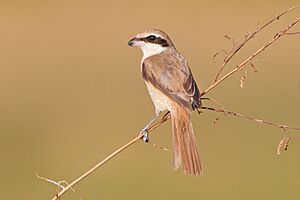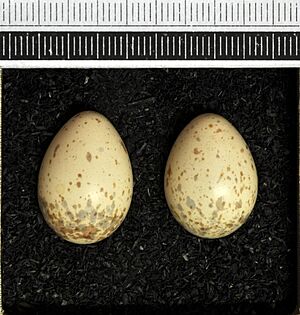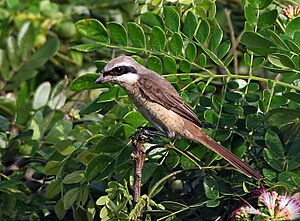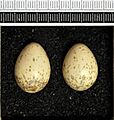Brown shrike facts for kids
Quick facts for kids Brown shrike |
|
|---|---|
 |
|
| In Thailand | |
| Conservation status | |
| Scientific classification | |
| Genus: |
Lanius
|
| Species: |
cristatus
|
 |
|
| Breeding ranges | |
| Synonyms | |
|
Otomela cristata (Linnaeus, 1758) |
|
The brown shrike (Lanius cristatus) is a fascinating bird found mostly in Asia. It belongs to the shrike family, known for their unique hunting style. This bird is a close relative of the red-backed shrike and isabelline shrike.
The name Lanius comes from a Latin word meaning "butcher". This is why some shrikes are also called "butcher birds." They got this nickname because of how they catch and store their food. The word cristatus is also Latin, meaning "crested." The English name "shrike" comes from an old word, scríc, which means "shriek." This refers to the bird's loud call.
Like many shrikes, the brown shrike has a clear black "bandit-mask" across its eyes. You can usually find them in open areas with bushes. They like to sit on top of thorny bushes, looking for their next meal. Different groups of this widespread bird live in various parts of Asia. They fly to warmer, tropical parts of Asia for the winter. Sometimes, they even show up in places like Europe and North America by accident.
Contents
Meet the Brown Shrike: What Does It Look Like?
The brown shrike is mostly brown on its upper body. Its tail is rounded. The black mask across its eyes can look lighter in winter. It also has a white stripe above its eye. The bird's underside is a creamy color, with reddish-brown sides and belly. Its wings are brown and do not have any white patches.
Female brown shrikes often have faint wavy patterns on their underside. Their eye mask is dark brown and not as clear as the male's. It can be hard to tell males and females apart just by looking. However, scientists can often tell them apart by measuring different parts of their bodies.
Some brown shrikes, like those from the lucionensis group, have a grey top of the head. This color blends into the brown on their back. Their lower back might look more reddish-brown. Young birds from this group have a brown head and no grey. Another group, superciliosus, has a wide white stripe above its eye. They also have a richer reddish head. Their tail is redder and has a white tip.
Where Do Brown Shrikes Live?
The main group of brown shrikes breeds in northern Asia, from Mongolia to Siberia. They spend their winters in South Asia, Myanmar, and the Malay Peninsula.
Another group, superciliosus, breeds on islands like Sakhalin and Japan. They fly to places like Hainan, Sumatra, and Java for the winter. The lucionensis group breeds in Korea and eastern China. They usually spend their winters in Taiwan and the Philippines. They can also be found on the Andaman Islands and in parts of India.
It is rare to see this bird in Europe. Sometimes, brown shrikes even wander off course and are seen in the United States and Canada.
How Do Brown Shrikes Behave?
Brown shrikes are migratory birds. This means they travel long distances between their breeding and wintering grounds. Studies show that they often return to the same wintering spots each year.
When they arrive in their winter homes, they quickly set up their own territories. Their loud, chattering calls are easy to recognize. Birds that arrive early and claim a territory seem to have an advantage. Their migration schedule is very regular. They usually arrive in India for winter in August and September. They then leave in April. During winter, they grow new feathers.
Their song in the winter is soft. It sounds a bit like the call of the rosy starling. They often copy the calls of other birds too. When they sing, their beak stays closed. Only their throat moves, and they bob their tail up and down.
The brown shrike's breeding season is in late May or June. They build their nests in trees or bushes. Their breeding areas include forests and even semi-desert regions. A female shrike will lay two to six eggs.
What Do Brown Shrikes Eat?
Brown shrikes mainly eat insects, especially Lepidoptera (butterflies and moths). Like other shrikes, they have a special way of storing food. They will push their prey onto thorns or sharp twigs. This helps them hold the food while they eat it. Sometimes, they also hunt small birds and lizards. They have even been seen storing a white-eye bird.
They usually hunt by watching from a high spot, like a branch. Once they spot prey on the ground, they fly down quickly to catch it.
Images for kids










